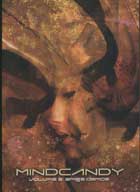
Mindcandy Volume 2: Amiga Demos 2006
Distributed by Microcinema International/Microcinema DVD, 1636 Bush St., Suite #2, SF, CA 94109; 415-447-9750
Several Producers
Directed by n/a
DVD, color and b&
Sr. High - Adult
Film Studies, Media Studies, Computer Science
Date Entered: 05/25/2007
Reviewed by Oksana Dykyj, Head, Visual Media Resources, Concordia University, MontrealThis follow-up to the first Mindcandy compilation from 2002 includes 30 Amiga demos from1989 to 2004. Amiga computers were sold by Commodore from 1985 until Commodore went bankrupt in 1994. These animated demos were produced for demo-parties at which groups of enthusiasts got together to push the limits of what the Amiga could do. They attempted to utilize the graphics and sound capabilities with all the computing power they had at hand. The international but mostly European scene of 800 members from 35 countries developed demos trying to outdo each other and this Mindcandy compilation has assembled 30 important winners from these competitions. The DVD is an attempt at archiving historically significant born-digital moving image materials. Kudos must go to the Mindcandy people for gathering various obsolete old models of Amiga computers so that they could capture all the demos in real time without emulation.
The commentary tracks and extras help to contextualize the enthusiasts and their contribution to digital and computer animation. Not only can we see the influence that these cutting edge demos would have had on the gaming aspect of computer science, we can also observe the evolution of computer animation art in its effect on techno-related music and the aesthetic of the rave. The interrelationship of music sampling and computer generated music video becomes clearer as one watches the chronologically ordered demos with the last one, Silkcut (2004) actually sampling dialogue from Martin Scorsese’s Gangs of New York. The artists working with Amigas since 1994 are like filmmakers who want to work with obsolete film or video formats because of the capabilities and look of the product produced by the hardware. Luckily this segment of computer animation history is not lost to us. Recommended for anyone interested in the history of computer animation.